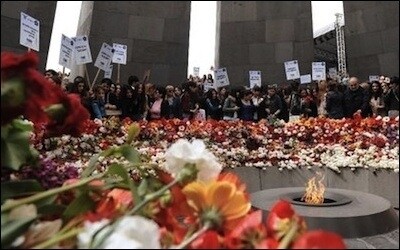Stefan Ihrig, Justifying Genocide. Germany and the Armenians from Bismarck to Hitler. Cambridge: Harvard University Press, 2016. ISBN 978-0674504790; 472 S.; EUR 31,50.
The Dresden Sinfonia Orchestra recently prepared a memorial concert called “Aghet,” the word for “catastrophe” in Armenian, in memory of Ottoman massacres. On 13 November 2016 the event, funded by the European Union and Berlin’s Foreign Office, was scheduled in Istanbul’s German Consulate General, to launch the first Armenian-Turkish-German friendship society. The invites had been mailed when Berlin suddenly postponed the show, most likely in response to protests by the Turkish government in light of the Armenian Genocide Resolution passed by the Bundestag on 2 June 2016.[1]
Stefan Ihrig’s book probes the long past of German responses to the massacres against Armenians. Known for his book on “Atatürk in the Nazi Imagination,”[2] Ihrig, a fellow at the Van Leer Jerusalem Institute, claims that the Armenian Genocide got too little notice in histories of National Socialism and the Holocaust. This genocide - his hypothesis - was well known when Hitler came to power and subsequently became closely tied to the Holocaust.
Ihrig wants to show what was lost and rediscovered on Germany’s road to the Shoah. To him, the Armenian Genocide was of towering importance as the original sin of the 20th century, if not a double sin: An empire killed its own civilians, came close to extinguishing an ethnic group, and the perpetrators were never punished. There might even be a third dimension to this sin - see the orchestra story. To this day it is still not possible to remember the genocide and to reconcile the communities involved through a more generally accepted multilateral history.
Until Hitler’s reign, the Armenian genocide was the biggest modern murder of an ethnic group.
The author mostly uses secondary sources, the press and books of the time. He studies discourses and their consequences, “not the actual events on the ground” (p. 8). He is interested in German debates on the massacres and poses a profound question: How could the Germans have lead the “great debate” on the genocidal nature between 1919 and 1923, only for parts of them to commit another, even more unimaginable genocide?
Ihrig’s book has four parts, each divided into four chapters. “Armenian blood money” deals with: the Bismarck era, Armenian horrors in the 1880s, the triumph of anti-Armenianism, and tells the story from the Young Turk’s revolt to the abyss. “Under German noses” covers: notions of total war, dispatches from Erzurum, interlude of the Gods, and what Germans could have known. “Debating genocide” weighs: war crimes, guilt and whitewashing, a 1921 murder, and the win of justifications. “The Nazis and the Armenian Genocide” contains: the racial debate, the Nazis and New Turkey, the missing smoking gun, and Armenian writings on the wall.
A 1915 march of Armenian civilians to the prison of Mezireh. |
Some key results (pp. 356-358) can be summarized in the following four paragraphs. Until Hitler’s reign, the Armenian Genocide was the biggest modern murder of an ethnic group. But its presence in German debates made such a murder more conceivable. Largely, the German nationalist press justified the dehumanization of Armenians as a “national or racial group” in the 1920s. Nationalist papers looked at the genocide chiefly through anti-Semitic lenses. Radical ethnic engineering, however, was not something that the Nazis had to study abroad. It had long been established in the racialist thought all around them.
There were parallels between the Armenian and Jewish genocides: Killings took place under the cover of a world war, away from population centers and after the target population had been removed from their places of mixed residence. Deportation was part of the extermination as death by expulsion was an element of ethnic restructuring schemes. “Vacated” properties were given to members of the main ethnic group in form of organized robbery. Physical violence was prepared through an anti-minority discourse that branded the group as the “other” who allegedly had threatened the very survival of the state from within by their existence.
The Armenian and Jewish genocides both took place after target populations were removed from places of mixed residence.
Ihrig also mentions striking differences, for instance that some Armenian women and children were taken away to be “Turkified,” converted and used as additional wives instead of being killed, though a larger number were slain. Thus, no Holocaust without the Armenian Genocide? No, says Ihrig. Although the two events happened a “mere 20 years apart,” one cannot know what would have happened without the example of the Armenian Genocide, even though the Nazi Jew hatred inherently tilted to very violent ends.
However, for Ihrig the two genocides were intimately and directly linked. The first one caused an enormous “motivation” as identified in the Nazi discourse of new Turkey in the interwar era and by a lack of a general deterrent, intervention against, and punishment of the real perpetrators. Has the world done enough to deter states from butchering civilians after World War II? (No, look at Syria’s Aleppo or Dair az-Zur 100 years ago and now.)
The greater theme in Ihrig’s question is how European, and later American powers dealt with minorities and reforms in the Mideast, especially in the Ottoman Empire and its successor states. There are patterns for Jews, Christians and all the others who resisted Islamization. Westerners created policies toward non-Muslim minorities to enhance their stance and to secure their sway.
During his research, Ihrig must have read inter-war texts on Berlin’s Mideastern or Islam policy. Still, in his book he often leaves out these German policies, though their results backed the deadly anti-minority ideologies and formed half of the story. Just think of the Tanzimat reforms in 1839, 1856 and 1876; the Kaiser’s jihad plot, the German-Ottoman jihadization of Islamism; German calls to jihad against the enemy powers in their colonies which turned into the lethal persecution of local non-Muslim civilians; the deployment of German experts, weapons and media for Muslim brotherhoods; false news on a “revolt by all Armenians;" Berlin’s advice to take Armenian families hostage; the attempted genocide against Palestine’s Jews; the Ottoman Balfour Declaration; the renewed pact between Nazis and Islamists; genocidal plans or deeds against Mideastern Jews; and Armenians in occupied Soviet regions.[3]
This book does not aim to uncover some intentions of central political actors as one might gain by analyzing primary sources first, then comparing them with published sources and synoptically weighing historical results. The realities of discursive narratives can be very different from the hidden intent. Ihrig complains about the absence of the Armenian Genocide in books on National Socialism and the Holocaust. But he overlooks many scholarly publications on Islamism and genocide since Wilhelm II or on the National Socialists and Islamists which explore the motives to kill and the ideologies behind genocides. As already mentioned, Ihrig aptly describes the “great Armenian Genocide debate” between 1919 and 1923 in Germany. But he could also have analyzed the “pre-debate” on “future killings” between 1894 and 1914.
From the Mideast, German clerics sent letters to the press on observations of “Armenian horrors” from 1894 to 1896. The Schleswig-Holsteinischer Sonntagsbote showed their pattern: men were disarmed, killed, also by Kurds; women and children were taken away, then separated, soon sold or starved; many properties were confiscated; the Berlin pact of 1878 offered no help.[4] A decade later, the Kaiser visited Istanbul. In 1908[5] he knew that asking Istanbul for jihad in an upcoming European war might endanger the minorities living under the Ottomans. Shortly before World War One emerged another part of the mentioned “pre-debate” on “future killings” in the dispute[6] between the Islam scholars Carl Heinrich Becker and Snouck Hurgronje: on lethal dangers for non-Muslims, the Christians and Jews, when demanding an Ottoman jihad. A sponsor thereof, the Kaiser, knew the grave risks of an axis with the Young Turks and their jihad against “infidel” Ottoman minorities. Identifying key results and ideologies, in the post-debates on killings a witness of that drive against Armenians, Max von Scheubner-Richter, fully blamed “Islamism and Turkism.”[7]
Visitors lay flowers at the Tsitsernakaberd Armenian Genocide Memorial in Yerevan, Armenia on April 21,2015.(AFP) |
Also, “Völkermord” comprises a plural, murder of peoples (p. 9), not only “Vernichtung eines Volkes.” Genocide was rarely the murder of a “nation,” - a term which has more a Western, but not so deeply rooted Mideastern meaning - rather of ethno-religious groups. Both world wars carried multiple genocides or “Völkermorde.” In 1915 culprits claimed more religious supremacy, in 1941 more racialist supremacy. Each was driven by different but compatible totalitarian ideologies that grew out of different cultures.
The author shows effects of the Armenian Genocide in the Jewish genocide, for example how Franz Werfel’s “The 40 Days of Musa Dagh” lead Palestinian Jews in 1942 to turn Mount Carmel into their refuge (p. 369).[8] Thus, there might be a point in calls to the Knesset to officially recognize the massacres on Armenians as a genocide, as suggested by its Speaker Yuli Edelstein and by Zehava Galon a few months ago. Dresden’s Sinfonia Orchestra might also turn to Jerusalem for its next memorial concert.[9]
To sum up, Ihrig’s discourse analysis sheds new light on important aspects related to the profound question he raised. On the one hand, he presents many striking insights on how the Nazis watched and used the new Turkey for their ideology and propaganda. They were well aware of the Armenian Genocide while preparing the Jewish genocide. In this regard, Ihrig was able to prove his hypothesis.
On the other hand, Ihrig’s methods and his selection of sources seem to be too narrow to give a more complex answer, which would have to include an analysis of unpublished key sources on genocidal intensions during the Third Reich with the Armenians in mind.
All in all, Stefan Ihrig offers a remarkable study and points towards a true multilateral and trans-regional history on the manifold ties between major genocidal crimes of the past century.
Wolfgang G. Schwanitz (@wolfggschwanitz) is a Middle East historian and Hochberg Family Fellow at the Middle East Forum.
[1] See Mitteldeutscher Rundfunk: “Auswärtiges Amt sagt ‘Aghet'-Konzert der Dresdner Sinfoniker ab”, 25.10.2016, Bundestag Resolution 02.06.2016.
[2] Stefan Ihrig, Atatürk in the Nazi Imagination, Cambridge, MA 2014. See also Klaus Kreiser: Rezension zu: Ihrig, Stefan: Atatürk in the Nazi Imagination. Cambridge, MA 2014, in: H-Soz-Kult, 14.07.2015.
[3] For overviews on ties between Germany and the Mideast in those periods see, for instance, my books Islam in Europa, Revolten in Mittelost, Berlin 2013, 2nd ed. 2014; with Barry M. Rubin, Nazis, Islamists and the Making of the Modern Middle East, New Haven, 2014; and Rolf Hosfeld, Tod in der Wüste, Der Völkermord an den Armeniern, München 2015, also my review in Geschichte.Transnational, 09.10.2015.
[4] See missionary Reports, Letters and News on Armenians in the Ottoman Empire, in: Schleswig-Holstei-nischer Sonntagsbote, Bordesholm, 13.10.1895, 10.05.1896, 17.05.1896, 02.07.1896, 20.09.1896, 27.09. 896; see also my article Heimterror, in Explizit.Net, 4(13.06.2016)225.
[5] On 1908 see my text Papst Franziskus und Kaiser Wilhelm am Bosporus, in Explizit.Net, 2(01.12.2014).
[6] See my articles Djihad »Made in Germany«: Der Streit um den Heiligen Krieg 1914–1915, in Sozial. Geschichte, 18(2003)2, pp. 7-34: Max von Oppenheim und der Heilige Krieg. Zwei Denkschriften zur Revolutionierung islamischer Gebiete 1914 und 1940, ibd., 19(2004)3, pp. 28–59; and Zürcher, Erik-Jan, ed., Jihad and Islam in World War I, Leiden 2016.
[7] Leverkuehn, Paul, Posten auf ewiger Wache, aus dem abenteuerreichen Leben des Max von Scheubner-Richter, Essen 1938, p. 34; facsimile of the Islamism quote and evaluation in my book Mittelost Mosaik 2014, Berlin, 2016, pp. 173-180.
[8] Stefan Ihrig, Justifying Genocide, p. 369.
[9] “Knesset committee recognizes Armenian genocide,” in Ynet.com, 8/1/2016, “Knesset speaker urges Israel to recognize Armenian genocide,” Times of Israel, 7/5/2016.









